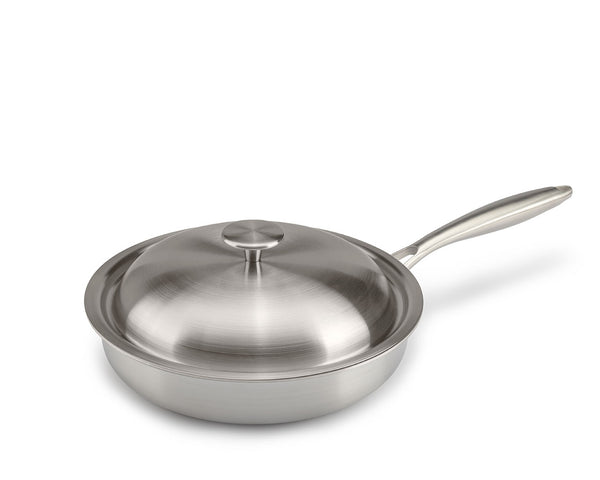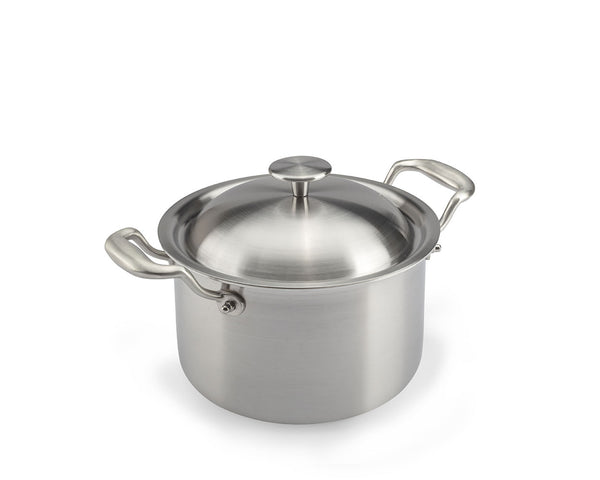HOW THE TRILAMINATE (OR TRI-PLY) WORKS
We have repeatedly said that the main advantage of multi-layer single-body cookware is the optimal distribution of heat over the entire surface of the pot, including the sides. This perfect heat distribution ensures uniform cooking, unlike pots with applied bottoms.Taking advantage of the high thermal conductivity of the aluminum core, the multilayer also ensures effective temperature regulation during the various cooking phases.
However, the behavior of this material is peculiar, differing significantly from both non-stick pans and steel cookware with applied bottoms.
It is important to know this detail on a theoretical and above all practical level, gradually becoming familiar with the Tritania cooking units.
In terms of heat response, the behavior of TRITANIA cooking units is intermediate between that of non-stick pans and that of steel cookware. When cooking, in fact, you will have noticed that non-stick pans heat up very quickly, while steel pans, which generally have a very thick bottom, heat up much more slowly.
The graphs below show the heating times of a Tritania pan compared to a non-stick 'stone' pan and a steel triple-bottom pan. As you can see, the Tritania pan falls somewhere in between the two, with slightly higher times than the steel pan.


THE IMPORTANCE OF THE HEATING PHASE
What does this mean in practice? It means that we have to respect some basic guidelines, especially when we cook non-moist food in a Tritania pan and if we want to limit the use of seasoning (or even not use it at all)
Here they are
- Be patient while heating: if in fact we put food in the pan (steak, eggs) when it is not yet hot enough, it is likely to stick to the surface.
- Always cook food with low flame, in some cases (short cooking) we can even think of using the heat reflected by the lid and finish cooking with the fire off. Don't think that keeping the flame high will shorten the cooking time! This will not happen and instead we risk having the food stick to the bottom of the pan.
- In the final stages of 'wet' cooking, when we want the sauce to shrink or the broth to evaporate completely, we can raise the temperature a little. In this delicate phase you will have to carefully supervise the cooking process by lowering the flame again if necessary and by occasionally stirring the food with a spatula.
MAKE THE MOST OF THE NATURAL NON-STICK PROPERTIES OF TITANIUM
Titanium benefits from a certain natural non-stickness: it is not comparable to that of non-stick cooking units, but it is still superior to that of other metals.This feature also increases with use, so we recommend using Tritania cooking units initially for cooking moist food (stewed vegetables or meat) or with a normal amount of seasoning.
After this "break-in" phase, you can move on to cooking with little fat, always remembering to cook over moderate or low heat: by wisely dosing the temperature you will avoid the food from sticking and it will be very easy to clean the pans after cooking.

COOKING STEAK
Some cuts of meat are more suitable than others for the preparation of a good grilled steak without seasoning: sirloin is certainly one of them, because it associates flavor and tenderness to an adequate fat content. In this way it will be possible to avoid adding seasoning, which, by overheating, could alter the flavor of the meat. We recommend a slightly fatty cut with an adequate thickness (2 cm).
Metal is the ideal material to trigger the Maillard reaction. You know what I'm talking about right? It is the chemical reaction that takes place at temperatures between 140°C and 180°C, between the amino acids of proteins and sugars and gives rise to a beautiful brown color and that typical taste of 'roasted meat'. Titanium, thanks to its slight non-stick properties, will give you a hand in obtaining an excellent result.
Not all meats can easily trigger the Maillard reaction: beef contains the right quantity of sugars to develop this reaction, whereas in order to promote the caramelization of white meats (chicken, veal, pork) it is necessary to marinate them (with olive oil and spices) and eventually add wine or lemon or honey while cooking.
Let's see how to get a nicely browned steak with a Tritania pan:
- You will need to have the patience to heat the pan over high heat for a long time (about 4 minutes) to reach the right temperature
- After this time, place the steak, if possible at room temperature and well dried (wiped with paper towels) on the bottom of the pan and cook it without touching it until it comes off on its own. Only when you lift a flap you will see that it has reached a nice brown color you can turn it.
- During cooking it is necessary to wisely dose the heat ( if necessary lowering the flame) because the temperature must be kept constant.

COOKING EGGS
In case you want to cook an omelette or fried eggs, once again the secret lies in the correct temperature setting both when heating the pan and during cooking.- Let's look at fried eggs.
- Oil and butter lovers are divided on the right fat to use when cooking eggs. We recommend using a mix of both to prevent the butter from turning black.
- Heat it slowly over moderate heat, moving the pan so that it is evenly distributed (or using a bit of household paper for this purpose) . Only when the seasoning begins to ripple and sizzle slightly, place the eggs in the pan: if they open first, there is a risk of the egg white sticking to the bottom of the pan; if they open too late, there is a risk of burning them on the outside.
- Cook the eggs for just long enough for the egg white to set and the yolk to compact slightly on the bottom while remaining soft and creamy on top (about 4-5 minutes).
- However, if you want the egg white to be firm and the yolk to be almost liquid, add the egg white first, continue cooking for a while and then add the yolk.
- Add salt (only on the egg whites) and if necessary pepper and serve.
MILANESE RISOTTO
Risotto alla Milanese - yellow rice with saffron - is an internationally symbolic dish of the Lombardy tradition. There is a codified recipe for this dish, approved and deposited at the City of Milan with a special ruling that gives it the status of De.Co.: Denominazione Comunale ("Communal Denomination"). It requires the inclusion of the following ingredients: beef marrow, roast beef fat, chopped onion and butter (for the sauté), concentrated meat broth for cooking the rice, saffron (in pistils), aged Grana Padano cheese and butter for the creaming. Wine is not included.
We can obviously consider unorthodox recipes, but healthier and more digestible (with less fat) as well as delicate in taste, avoiding the use of marrow and roast fat, using a mix of butter and oil for the sauté and possibly using a vegetable broth.
As for rice varieties, nowadays Carnaroli is the most popular, but we suggest to take into consideration Vialone Nano, IGP, with a smaller grain, excellent cooking properties, high amylose content, therefore perfect for Risotto all'Onda.
The Tritania low casserole is perfect for cooking risotto, because it ensures uniform cooking and in no way alters the flavor of a food as delicate as rice. You can use the 26cm casserole for 3-4 servings and the 30cm casserole for 6-8 servings.
Finely chop the onion and place it in the saucepan together with a little oil and a small knob of butter, sauté slowly until it turns golden brown and add the rice (two fistfuls per person). Toast the rice for a few minutes over moderate heat to prevent it from burning: at this stage you can stir the rice with a spatula. Then begin to incorporate the boiling, salted broth a little at a time, stirring constantly so that the rice releases its starch. If saffron in pistils is used, it should be added immediately, whereas the saffron in sachets should be added at the end of cooking (dissolved in a ladle of broth).
When the saffron is cooked, remove the pan from the heat, add a ladle of broth, another dollop of butter and the grated grana padano (DOP, 24 months) and stir well in order to melt the butter and cheese and mix everything together. Let the risotto rest for a couple of minutes before serving.





